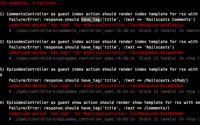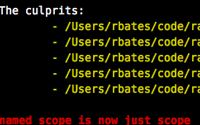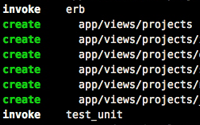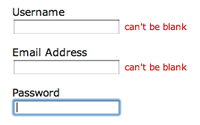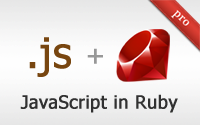Categories
- Active Record
- Active Resource
- Active Support
- Administration
- Ajax
- APIs
- Authentication
- Authorization
- Background Jobs
- Caching
- Code Walkthrough
- Controllers
- Debugging
- Deployment
- eCommerce
- Forms
- Mailing
- Models
- Performance
- Plugins
- Production
- Rack
- Rails 2.0
- Rails 2.1
- Rails 2.2
- Rails 2.3
- Rails 3.0
- Rails 3.1
- Rails 3.2
- Rails 4.0
- Refactoring
- Routing
- Search
- Security
- Testing
- Tools
- Views
Upgrading to Rails 3 Part 2
Here we continue upgrading an application to Rails 3 by getting our specs up and running and going through the rails_upgrade plugin.
(12 minutes)
Upgrading to Rails 3 Part 1
In the first part of this series on upgrading a Rails 2 application to Rails 3, we'll start off by setting up Rails 3.0 Release Candidate in a clean environment. The rails_upgrade plugin will then help us determine what needs upgrading.
(11 minutes)
Upgrading to Rails 3 Part 3
Here we finish up this upgrade series by removing all deprecation warnings and fixing some problems in the view.
(9 minutes)
Generators in Rails 3
Generators in Rails 3 have been completely rewritten to be more modular. This allows you to customize any generator to fit your specific preferences.
(11 minutes)
Pagination with Kaminari
If you need pagination in Rails 3 try out Kaminari. It is a clean, flexible solution which uses scopes to flow nicely with Active Record queries. Did I mention it also works with Mongoid?
(8 minutes)
Bundler (revised)
Bundler makes it easy to manage Ruby Gem dependencies. Learn how to use it in a Rails application, see what's new in Bundler 1.1, convenient ways to run bundle exec, and how to fix gem compilation issues.
(9 minutes)
Twitter Integration
Here I show how to integrate Twitter into a Rails app. This includes fetching data, caching it, and even how to authenticate as a user signing in to your application through Twitter.
(14 minutes)
Client Side Validations
Showing validation errors inline as the user is filling out the form can lead to a better use experience. Learn how to do this using the Client Side Validations gem.
(8 minutes)
Globalize3
Rails has great internationalization (I18n) support making it easy to translate static text into other languages, but how do we translate database content? Learn how using Globalize 3 in this episode.
(5 minutes)
Running JavaScript in Ruby
Sometimes logic needs to be shared between the server-side (Ruby) and the client-side (JavaScript). Here I show how to run JavaScript directly in Ruby through ExecJS and therubyracer.
(14 minutes)

